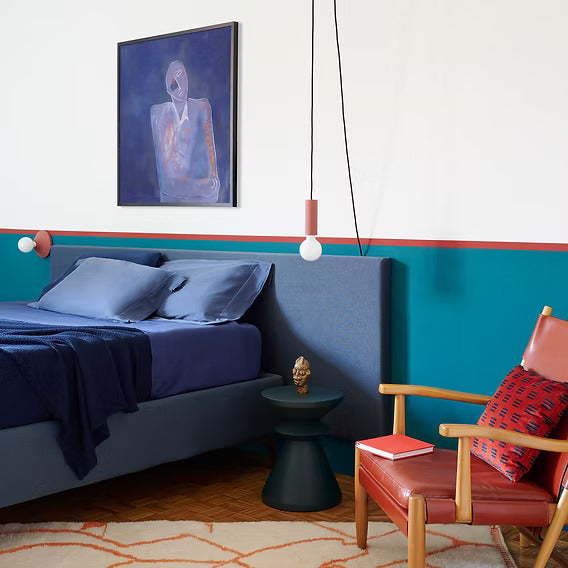Introduction: This article is a bit different from our usual ones. Fewer words, perhaps, and more practical examples. After all, we're talking about a delicate topic: when it comes to area rug placement and arranging them in various spaces of the home, there are no hard and fast rules.
Every house has its soul, and every inhabitant its style.

An elegant Casa Amar area rug positioned between two parallel sofas, with the front legs on the rug. Project: Nomade Architettura
The following suggestions are guidelines based on aesthetic and functional principles, but they are always adaptable. The goal is not so much to follow rigid patterns, but to harmonize area rugs with the environment and furnishings, creating welcoming, coherent, and lived-in interiors.
This harmonization isn't always easy or spontaneous. For this reason, at Casa Amar, we also offer a personalized consultation service with our interior designer. You can send us photos and a floor plan of your apartment: we'll create realistic renderings to show how each rug will fit into your space. We know this is a highly appreciated service because one of the biggest challenges is imagining what a room will look like with a particular area rug. Or how it might look different with another. Or, again, how it would change with a warmer or cooler color, a larger or smaller size.
To avoid mistakes and second thoughts, we are always at your side with consultations and this customized service. In 2025, proper rug placement has become even more important as open-plan living continues to dominate interior design trends.
But now here are some general indications to help us delve deeper into the topic.
What you will find in this guide
- Choosing the size of an area rug
- How to calculate the right rug size
- Living room area rug placement
- How to position area rugs in the living room
- Rugs to place in front of the fireplace
- How to position a rug and a linear sofa
- How to position area rugs with corner or peninsula sofas
- How to place a rug in front of a sofa
- How to place a rug between two sofas
- How to put a rug under the sofa
- Placing the area rug with a corner sofa
- How to position rugs with chaise longue sofas
- Mistakes to avoid in the living room
- Placing rugs in entryways and hallways
- Entrance: welcome and visual impact
- Corridor: length and rhythm
- How to arrange area rugs in open-plan living rooms
- Which rug to place under the dining table
- Bedroom area rug placement
- How to put the rug under the bed
- How to place rugs in the bathroom
- Kitchen rug placement guide
- How to place a rug under the kitchen table
- Which rug for kitchen-living room spaces
- Area rugs for home offices and professional studios
- Curiosity: rugs and Feng Shui
- FOCUS - Where does a round rug look best?
- Common rug placement mistakes to avoid
- FAQ
- Conclusion
Choosing the Size of an Area Rug
Choosing the right area rug size is a crucial first step. A rug that's too small risks being visually lost, while one that's too large can overwhelm the space.
For example, we distinguish rugs by dividing them in this way (you can see it in the e-shop menu):
-
Small
(up to 5.6x3.6 ft): ideal for entrances, kitchens, bathrooms, in front of armchairs or in isolated focal points. -
Medium
(up to 5.2x8.5 ft): perfect under coffee tables, at the foot of the bed or in small living rooms. -
Large
(up to 9.8x6.6 ft): suitable for spacious living rooms, double bedrooms or under dining tables. -
Very large
(over 9.8x6.6 ft): perfect for important spaces and rooms, exclusive pieces capable of bringing luxury and style to any context, whether private or public. -
Narrow and long (runners)
(up to 3.3x12.8 ft): designed for corridors, narrow entrances, linear kitchens or between the bed and wardrobe. -
Custom-made
Yes! We create handcrafted, custom-made area rugs (and even custom designs!), working with you to choose the perfect size for your room, along with the colors and finishes.






How to Calculate the Right Rug Size
The ideal size depends on the area rug's function and the furniture arrangement. Does this seem trivial? Some helpful principles:
-
Accurately measure the area to be covered.
A simple masking tape on the floor helps visualize the footprint before purchasing. -
Always create a visible floor "frame."
It's best to leave 8-12 inches of space between the area rug and the walls: this allows the room to breathe and prevents the rug from looking like wall-to-wall carpeting. -
Anchor the furniture to the rug.
At least the front legs of the main furnishings (sofas, armchairs, beds) should rest on the pile. In large living rooms, an extra-large area rug can completely accommodate the furniture, creating a well-defined conversational island. -
When in doubt, choose the larger size (as long as the floor frame remains).
A small area rug fragments the room; an excessive one risks "swallowing" it. If you're unsure between two sizes, opt for the larger one, but without overdoing it and remember to leave a visible border of flooring. Don't forget to use a quality rug pad to prevent slipping and protect your floors.

Tips for specific rooms:
- In the living room, the area rug should ideally encompass the entire conversation area. A common mistake is using rugs that are too small and end up "floating" in front of the sofa.
- In the bedroom, you can opt for a large rug that extends at least 20 inches on three sides of the bed, or for two lateral runners.
- Under a dining table, the area rug should be at least 24-30 inches wider than the table on each side, to allow for the chairs to slide in and out easily.
Some very quick and practical advice that we think is useful to remember:
-
Elegant layering
To layer two rugs, choose a neutral base (such as an unembroidered palm straw rug) and a second decorative area rug one size smaller. -
Non-slip rug pad
Cut it 2 inches shorter on each side: it remains invisible but blocks any movement. A good rug pad also extends the life of your area rug. -
Pile height
Generally speaking, we could say long pile for relaxation areas (bedrooms), low pile or flat weave for easy cleaning in the kitchen or under the dining table. It's all down to taste, though!

Living Room Area Rug Placement
Now let's get to the heart of the matter: let's discover, room by room, how to best arrange area rugs in each room.
A living room rug brings cohesion to the space, visually connecting different furnishings, and helping create a welcoming atmosphere. It's important to choose the right placement based on the size, furniture arrangement, and desired effect.
How to Position Area Rugs in the Living Room
- Area rug entirely under the sofa and armchairs: ideal for large living rooms, where the rug becomes the foundation of the entire arrangement. The rug covers all the furniture in the conversation area, including the back legs of the sofa. It's a very dramatic choice, perfect with large area rugs (at least 8x10 ft).
- Area rug with front legs on: one of the most popular and versatile solutions. The rug covers the central space between sofas, armchairs, and the coffee table, but without being overly invasive. It helps define the area without visually overpowering it. This is the general rule: front legs on the rug, back legs off.
-
Area rug in front of the sofa (detached): a lighter solution, suitable for small rooms. The rug is placed completely detached from the sofa, perhaps with a coffee table placed on top. It should be chosen in proportion to the length of the sofa so as not to appear too small or too large.
This solution usually works best with unique, statement-making rugs, those with a strong character, or those you want to highlight for their value. Like the example below, where you see a vintage Hassira rug: a little treasure to show off in all its beauty! - Layering area rugs: In more creative or boho settings, you can layer a smaller rug, with bold colors or patterns, over a larger, neutral base. This helps create movement and depth, even in minimalist spaces. Remember to use a rug pad between layers for stability.
- Using multiple area rugs in the same room: If the living room is large or open-plan, two rugs can be used to visually separate different areas (e.g., relaxation and reading areas). In this case, maintaining color consistency and balanced proportions is essential.
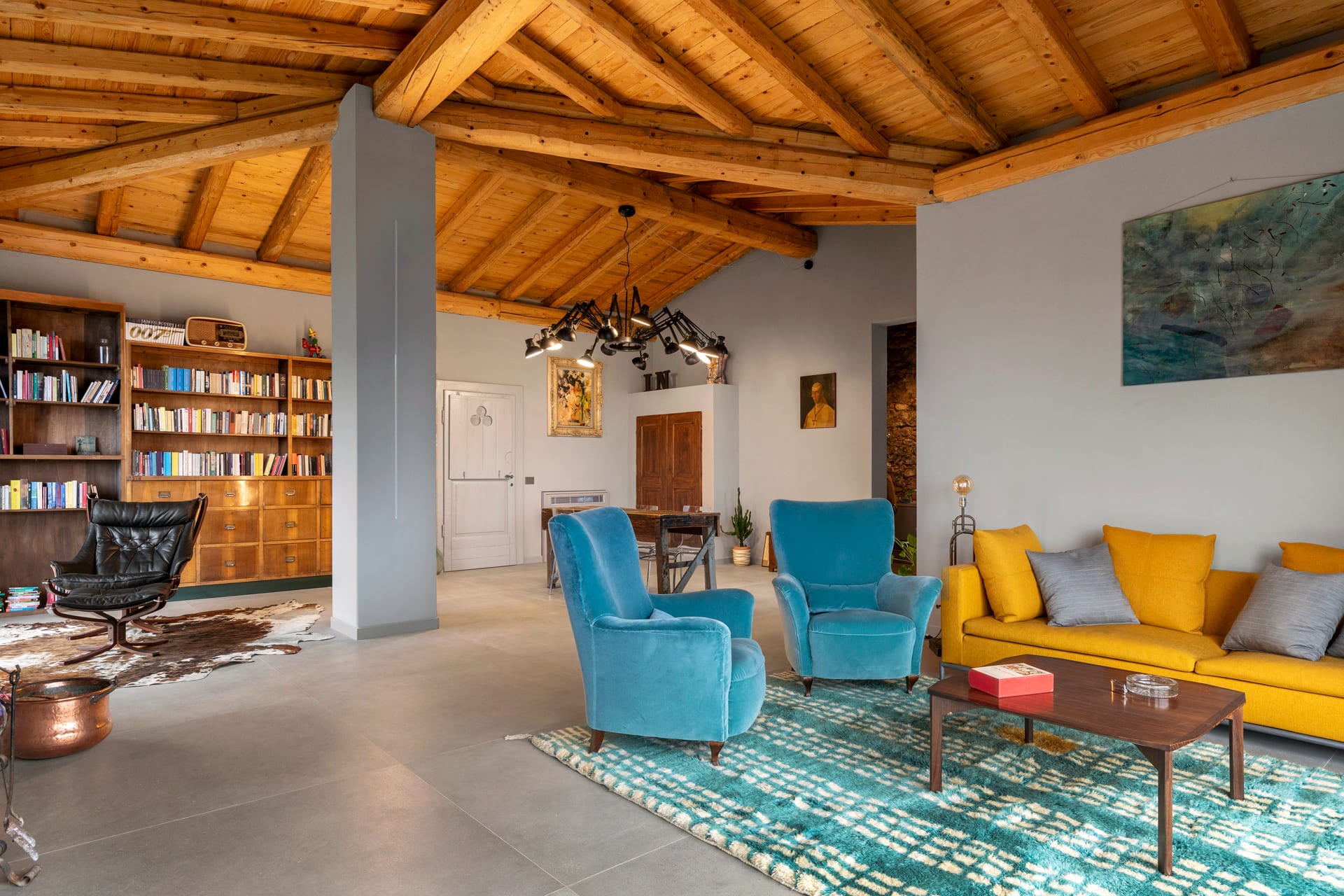
A relaxation area where the sofa, armchairs, and coffee table all have their legs on one of our gorgeous sky blue area rugs. Project: Lascia La Scia.

One of our area rugs is placed with the front legs on the rug in a long, narrow living room. Project: Nomade Architettura

A beautiful Moroccan straw mat with colorful geometric patterns is placed in front of, but not below, a yellow sofa. Project: Atypique Design Studio
Good positioning allows the area rug to interact with the rest of the furnishings and give a sense of order and planning, even in lived-in and informal environments.
What if there is a fireplace?
Rugs to Place in Front of the Fireplace
If you have a beautiful fireplace in your home, you may find yourself wondering if, how, and where to place a nice area rug to further warm the room. In this case, a rug in front of the fireplace is not only decorative, but also functional. It must be fireproof or at least heat-resistant—just like wool, on which the flame extinguishes itself—easy to clean, and securely anchored to the floor to avoid creases and tripping. Using a rug pad is essential here for safety.
You can opt for a small, rectangular or oval shape, positioned parallel to the fireplace. Warm, natural colors—such as earth tones, burnt red, or sand—amplify the welcoming effect, but these are just general guidelines; you should understand that the entire context needs to be evaluated (possibly with the help of an expert).
How to Position Area Rugs with Linear Sofas (2-3-4 Seats)
The rug-to-sofa ratio is crucial to the balance of a room. Trusting an interior designer is important to avoid mistakes, but we can also help you with your choice. Here, we're offering some general guidance to clarify at least the basic ideas.

How to Place a Rug in Front of the Sofa
An area rug placed entirely in front of the sofa can work if it's well-proportioned: the minimum size matches the width of the sofa, but not too deep. Perfect if you want to highlight the coffee table as a focal point.
How to Place a Rug Between Two Sofas
If placed facing each other, the area rug should fill the space between the two sofas, with equal margins on both sides. If there is a coffee table, it should be placed in the center, on top of the rug. The general rule of front legs on the rug applies here too.
How to Put a Rug Under the Sofa
In larger spaces, the area rug can extend under the entire sofa, including the back legs. This visual anchoring lends cohesion to the room and highlights important furnishings (perhaps a vintage piece or designer furniture). It's also an excellent solution when the sofa is in the center of the room and you intend to place a console table, bench, or bookcase behind the backrest.
How to Position Area Rugs with Corner or Peninsula Sofas

A chaise longue sofa with an area rug placed across the front, spanning the entire width of the piece. Design: Nomade Architettura. Photo: Simone Furiosi
Placing the Area Rug with a Corner Sofa
With an L-shaped sofa, it's best to choose a large area rug that extends along both sides and beyond the corner formed by the two seating elements. This way, the corner is enhanced and the relaxation area is clearly defined. The front legs on rule still applies for optimal placement.

How to Position Rugs with Chaise Longue Sofas
Here, it's important that the area rug follows the contours of the peninsula. The rug should extend at least 12-16 inches around the chaise longue, so as not to feel squashed or out of place. It also depends on the presence or absence of other furnishings (a beautiful plant, for example, or a small freestanding bookcase) and the positioning of the peninsula in relation to architectural features (wall, window, low wall, etc.).

Living Room Rug Placement Mistakes to Avoid
- Choosing an area rug that is too small disrupts the harmony of the space and makes the room appear smaller.
- Not considering the proportions of the furniture, leaving sofas and armchairs out of scale with the rug.
- Positioning the rug incorrectly with respect to the wall or architectural elements: it is better to leave a frame of at least 8-12 inches of exposed floor along the edges.
- Neglecting a good non-slip rug pad, which prevents slipping, protects floors, and extends your area rug's life.

Placing Rugs in Entryways and Hallways

An entrance hall with a window and a Casa Amar runner. Project: Atypique Design Studio.
The entryway is the first space you encounter when entering your home: an area rug plays an important role here, both functional and decorative. In the hallway, however, it accompanies the passageway and provides visual continuity. In both cases, a well-chosen and well-placed rug can transform even the narrowest or most anonymous entryways into spaces brimming with character.
Entrance: Welcome and Visual Impact

For the entryway, we recommend narrow, medium-length area rugs (e.g., 2.6x4.9 or 3x5.9 ft) or round ones, perfect for placing in front of the door or alongside a console table. A few guidelines:
- It is preferable that it does not touch the walls, but leaves a few inches of space at the sides.
- Choose durable, easy-to-clean materials that are suitable for high-traffic areas. Don't forget a quality rug pad here.
- From an aesthetic standpoint, you can opt for an area rug in neutral tones (quiet luxury) or play with patterns and bright colors for a striking first impression. It depends a lot on the overall context.
- Avoid light-colored rugs if the entrance opens directly to the outside. Constant washing isn't ideal.
Corridor: Length and Rhythm

For long, narrow hallways, runner rugs are ideal: elongated area rugs (e.g., 2.3x7.9, 2.6x9.8 ft), capable of drawing the eye and breaking up the monotony of the passageway. If the hallway is a larger or squarer entrance or hallway, a medium-sized rug is the way to go.
Some tips:
- It is preferable to keep 3-4 inches of floor uncovered on each side, so as to give definition and not make the rug appear "stuck".
- Consider the color of the floor and walls: a tone-on-tone area rug creates coherence, while a geometric design can give rhythm and direction.
- In dimly lit spaces, light, bright patterns help add depth and amplify the light.
In both cases , the area rug functions as an invitation, a path, a gesture that welcomes and tells something about you from the moment you enter. A small detail, but with great decorative potential.
🔎 Explore the collection of runner rugs and carpets

A large hallway/antechamber with a white Azilal area rug featuring multicolored geometric patterns (which echo the majolica tiles in the next room: brilliant!). Project: Atypique Design Studio.
How to Arrange Area Rugs in Open-Plan Living Rooms


When we talk about an open-plan living room, we mean the classic multifunctional living area: a single, open space that includes a seating area, dining table, and sometimes a kitchen. We distinguish it from the living room, which is a more intimate and formal space, dedicated exclusively to conversation and entertaining guests. In an open space, area rugs become fundamental tools for visually organizing the space, defining functions without the need for walls.
The most common mistake? Using a single rug for everything, resulting in a confusing and dull look.
But here are some guidelines for a balanced arrangement:
- Use separate area rugs for different zones: one for the living room, one under the dining table, and possibly a third in the kitchen area.
- Area rugs should be consistent with each other, but not identical: choose compatible shades and textures or patterns that complement each other.
- Avoid overlaps or misalignments between the rugs: each area must be legible and well-defined.
- If the room is very large, it is preferable for at least one area rug to be generously sized, so as to visually anchor the entire composition.
In this context, the area rug is a true design tool for giving structure, balance, and warmth to open spaces.
Which Rug to Place Under the Dining Table

A glass and metal table and wooden chairs are perfectly framed by a large white area rug with a blue border. Photos courtesy of our customers.
When choosing an area rug for your dining table, always remember a few rules that apply to any shape:
- the rug must be large enough to include both the table and chairs in all their positions
- It should be short-pile or flat-weave to facilitate the sliding of the seats
- It must be easy to clean, to ensure hygiene and practicality
- allow at least 24-30 inches of overhang on each side from the table
- prefer resistant materials like wool
1. Area Rug Under Rectangular Table


Area rugs placed under the dining table must meet two criteria: proportion and practicality. The main rule is simple and always valid:
💡 The area rug must extend at least 24 inches beyond the edge of the table on each side, so that the chairs always remain completely supported on the rug even when pulled out.
This precaution avoids annoying unevenness and maintains the visual balance of the whole. A good rug pad is essential under dining room rugs.
From a material standpoint, the winning choice is sturdy, easily washable, and low-profile fabrics: it's best to avoid excessively high piles or thick textures that hinder the chairs' sliding motion. Wool remains unbeatable even in frequently used environments, thanks to its durability and natural self-cleaning ability to repel dirt.
👉 Speaking of wool rugs, here's a post on everything you need to know (production, characteristics, maintenance, and many other curiosities).
Stylistically, we suggest regular geometric patterns or dense micro-designs, ideal for masking any stains and adding rhythm to the space without overwhelming it. A good area rug under the table anchors the dining area and helps integrate it harmoniously into the open-plan living room.
For rectangular or extendable tables, always make sure the rug size covers the maximum extension of the table. It's better to go larger than risk a "skimpy" look.
2. Area Rug Under Square Table


The same rules of proportion apply to a square table: the area rug must extend by at least 24 inches on all sides, so as to easily include the chairs even when they are moved back.
A square rug, centered on the table, enhances the symmetry of the room and creates an orderly perception.
3. Round Table Rug


If the table is round, it's best to choose an area rug of the same shape or a large, well-centered square rug. For round tables, the rule of 24 inches beyond the circumference always applies to allow chairs to rest on the rug. This proportion promotes stability, prevents tripping, and maintains visual harmony.
It's better to go larger than risk a "skimpy" effect. Furthermore, simple or geometric patterns can complement the dining area without stealing the show, while flat-weave wool remains practical for everyday use.
Bedroom Area Rug Placement
Knowing how to place area rugs in the bedroom means creating a welcoming, balanced, and visually harmonious environment. Rugs have both an aesthetic and sensorial function: they complement the room's style and provide a pleasant sensation underfoot.


How to Put the Rug Under the Bed
Positioning varies depending on the size of the room and the type of bed. The most effective configurations are:
-
Large area rug under the bed (centered):
Covers the entire visual area of the sleeping area. The rug extends beyond the perimeter of the bed by at least 24 inches on both sides and the bottom, leaving only the bedside table areas uncovered. It's the most elegant and balanced choice, ideal for double beds. In addition to the layout, it's important to choose soft, tactile area rugs in soothing or neutral shades (ivory, warm gray, beige, sage green). The right texture transforms the sleeping area into an intimate and rejuvenating space. And in the winter, how wonderful is it to get out of bed and land on soft ground? The most harmonious way to place an area rug under the bed is to center it with respect to the frame, leaving it protruding at least 24 inches on the sides and bottom. This creates a balanced visual frame and a soft surface to rest your feet on when you wake up.
The bedside tables can be left outside the rug, placed directly on the floor: this way, the area rug doesn't appear too large, but maintains a formal balance. If space permits, you can opt for a very large rug that also includes the bedside tables, but only if the room supports it. -
Area rug at the foot of the bed:
Smaller (e.g., 5.6x7.9 ft or 6.6x9.8 ft), placed only at the end of the bed. It's a lighter yet visually effective solution, perfect for compact rooms or king-size beds where oversized rugs are unnecessary. This solution adds depth to the room without weighing it down. -
Two side runners:
A pair of long, narrow area rugs on either side of the bed. A very functional choice, especially if space is limited. Recommended for rooms with hardwood floors, to add comfort and warmth. -
Only one side rug:
Placed on the most visible and largest side of the room (the one opposite the wall), it can replace traditional twin rugs with a simpler yet equally decorative solution. It's ideal if the bed is close to the wall on one side but has plenty of free space on the other (as in the photo below).
➡️ Ideas and inspiration for ideal bedroom area rugs? Find them all here.

A double bed flanked by a large area rug, arranged asymmetrically for an original and dynamic effect. Design: Chantal Forzatti Architect.
How to Place Rugs in the Bathroom

The bathroom is perhaps the last place you'd expect to find a handcrafted area rug. Yet, in sophisticated interior design projects, a luxury rug can be the element that completely transforms the space, elevating it from a functional space to a small oasis of well-being.
We're talking, of course, about large, well-ventilated bathrooms designed with a home spa in mind: spaces where natural materials, neutral colors, and soft lighting contribute to a refined and relaxing aesthetic. In these settings, a Berber rug or small kilim can visually warm the space, creating a refined contrast with ceramics, stone, or microcement.
👉 Confused about the names of Moroccan rugs? In this post, we'll define them all and explain how to distinguish them and learn about them.
A bath mat, even a small one, can completely transform a space by adding comfort and style. The ideal position is in front of the sink, shower, or tub, offering a warm, soft surface to rest your feet on. For added safety, it's always advisable to add a non-slip rug pad underneath the mat and choose easily washable models.
From an aesthetic standpoint, neutral shades (sand, light gray, cream) and natural tones like powder blue or sage green work very well, immediately evoking a sense of well-being and a clean, fresh feeling. Stripes and organic geometric patterns are also perfect.

A blue and white striped area rug placed in front of the bathroom vanity. Photos courtesy of our customers.
Among the most popular practical materials are thick cotton, microfiber, or linen blends with a latex backing, but for those who aren't afraid to show character even in the bathroom, a small Moroccan wool area rug or a beautiful Boucherouite made from recycled materials can be a touch of class and wow effect.
🪄 Casa Amar Advice Moroccan area rugs, if placed in the bathroom, must be part of a conscious aesthetic project, where beauty and functionality find a measured balance.
Have you ever thought about using wool in the bathroom? Well, you might be surprised, but wool isn't afraid of water and splashes, so you can place the rug wherever you like: under the sink, in front of the tub, or in a relaxation area. Just a few simple steps are all it takes to keep them sanitized.
📖 Read here how to care for wool area rugs
➡️ Discover all our rugs designed for a truly unique bathroom
Kitchen Rug Placement Guide

Adding an area rug to the kitchen may seem like a risky choice, but in reality—if carefully planned—it can add character, color, and warmth to one of the most lived-in rooms in the home, often overlooked from a decorative standpoint. Naturally, we're talking about kitchens where aesthetics play a key role, perhaps open to the living room or integrated into the dining area.
A kitchen area rug should be practical, safe, and easy to clean. Choosing the right one enhances the workspace without sacrificing functionality: it not only decorates, but also enhances the daily experience by offering a more comfortable surface to walk on.
The most suitable models are long, narrow runners (e.g., 2.3x7.9 ft), perfect for placing in front of the sink or along the cooktop in linear kitchens. In larger spaces, such as kitchens with an island or peninsula, larger area rugs can be used, firmly anchored to the floor with a rug pad to ensure stability and safety.
The recommended materials for a kitchen area rug are:
- Flat weave wool, for those seeking a distinctive style and high durability
- Machine washable cotton, ideal for everyday use without too many worries
- Water-repellent and stain-resistant fibers or materials, excellent for areas subject to splashes and crumbs
- Among the Moroccan rugs we could recommend the Boucherouite rugs, creative, versatile and super practical even in the kitchen!

A long, narrow kitchen with a wool runner. Photos courtesy of our customers.
It's best to avoid piles that are too high and could cause tripping, or delicate textures where stains would be immediately visible.
The choice of colors is also fundamental: dark tones or dense patterns help to hide small accidents and keep the look well-groomed for longer.

A stainless steel kitchen enlivened by a multicolored boucherouite area rug. Photos courtesy of our customers.
As always, even in the kitchen area , Casa Amar rugs should be understood as handcrafted design elements, not disposable solutions: for this reason, it is essential to integrate them into a coherent aesthetic project, where beauty and functionality interact equally.
➡️ Concerned about which area rug to put in the kitchen? Here they will disappear.
How to Place a Rug Under the Kitchen Table
If there is a dining table in the kitchen, the same rules already seen in the dedicated section apply: the area rug must exceed the perimeter of the table by at least 24 inches on each side, so as to include the chairs even when they are moved aside.
We recommend low-pile or flat-pile area rugs, and dense or geometric patterns that help hide any imperfections or wear over time.
If the table is round, it's best to choose a rug of the same size or a well-centered square. For rectangular tables, be careful to choose a size proportionate to the maximum length (especially if extendable).
Which Rug for Kitchen-Living Room Spaces

In the case of a kitchen that opens directly onto the dining area, you need to go a step further: coordinate the area rug, chairs, furnishings and flooring, avoiding visual overlaps or stylistic discontinuities.
The rule of proportion always applies, but color and material harmony becomes even more crucial: the wrong rug risks disrupting the room's balance. If you have a complete open-plan space—kitchen, dining room, and living room all in the same room—the mix and match issue requires even more attention.
A simple but effective tip: avoid area rugs with overly different shapes (e.g., a round one under the table, a rectangular one in front of the sofa, or a runner in front of the kitchen). The effect would be fragmented. It's better to aim for stylistic coherence, possibly varying the size or patterns, but maintaining a common thread between the different areas.
Pay attention to color/material combinations! 👉 For more information on the best color and style combinations, check out our post on how to choose the right rug color!
Area Rugs for Home Offices and Professional Studios

An area rug under your desk serves primarily to define your work area, dampen noise, and bring visual warmth to spaces often dominated by hard surfaces. For it to truly work—and not become a hindrance—we recommend following a few simple technical rules:
- Generous dimensions. The area rug should extend at least 28 inches behind the chair: this way, the seat remains on the pile even when it's pushed back. A 5.2x7.5 ft rectangle is the minimum size for a standard desk; in larger offices, it can be up to 6.6x9.8 ft.
- Low pile or flat-weave, tightly woven. A chair with casters is best with a pileless or short-pile wool kilim rug: the casters glide effortlessly, the surface won't warp, and cleaning is easier.
- Stability and safety. A good non-slip rug pad, cut 1-2 inches shorter on each side, prevents unwanted movement and protects the hardwood flooring.
- Visual proportions. The area rug should "frame" the entire workstation, including the desk, dresser, and, if applicable, guest chair. Always leave 8-12 inches of exposed flooring along the edges to avoid overcrowding the space.
- A consistent palette. In modern offices, elegant neutrals (warm gray, greige, anthracite) or subtle, non-distracting geometric patterns work well. In creative studios, colorful kilims or other Moroccan area rugs in earthy tones are a good choice, as long as the pattern doesn't visually interfere with cables and electronics.
By following these guidelines, an area rug under a chair with casters not only protects the floor and improves acoustics, but also becomes an integral part of the aesthetic design, strengthening the professional identity of the workspace.
Alternatively, you can also choose to place the area rug next to the desk, to create a small relaxation area or define a reception area within the office. A more creative and less conventional approach, it allows you to add character to the space without interfering with the functionality of the desk chair.

Our workspace in the Casa Amar showroom in Milan. Here we've placed the area rug on its side, but if you look closely, you'll also see a small Zindekh rug converted into a painting.
Area Rugs in the Children's Bedroom



We know that in children's bedrooms, the importance of an area rug is often overlooked, choosing a cheap solution, thinking "it'll get ruined anyway" or "they'll grow out and need a new style or color." In a child's room , an area rug is simultaneously a decorative element, a play area, and a protective space. It should be chosen with particular attention to safety, hygiene, and visual stimulation. And regarding safety, remember that wool is also hypoallergenic and capable of purifying the air in the room where it is placed.
We always recommend keeping sustainability in mind, especially when teaching our children. We therefore recommend purchasing an area rug that's built to last, both in terms of materials and quality, and in terms of aesthetics. That cute little princess or toy car rug will inevitably have to be thrown out once it reaches a certain age. This is a waste. One idea is to be forward-thinking and focus on a design that stands the test of time and changing tastes.
The best models are made of flat-weave or short-haired wool, or washable cotton, with non-slip backing (rug pad) and no fringes to avoid tripping.
How to place the area rug in the bedroom?
In the center of the room to create a soft play area, as a bedside rug, or to identify a relaxation area for shared reading or safe play.
The designs? Simple, geometric motifs are best, but you can also go bold with cheerful patterns or stylized animals, depending on the decor style. Who are we to stop your creativity?

A bedroom for two children with twin beds flanked by a large striped area rug created by our artisans based on a design by Oi Mini Design. Project: Oi Mini Design
🪁 In our fun collection of Moroccan area rugs for the nursery, you'll find plenty of color and beauty, soft rugs for those first steps or for playing with Lego. Plus, don't miss the limited edition Oiminidesign pieces, a design studio that's a go-to for all parents who want a state-of-the-art nursery!
Area Rugs for Reading or Relaxation Corners
A small reading nook with an armchair and a lamp? Or a relaxation area next to a bookcase? Even in these cases, an area rug can visually define the space and make it more welcoming, creating a room within a room.
A small rug (e.g., 3.9x5.6 ft) is sufficient. You can choose one that matches the surrounding environment or one with a strong personality, to separate that space from the rest of the living room, creating a space dedicated solely to your moments: reading, introspection, meditation, or a glass of wine when everyone is finally in bed after a long day.
It should be placed under the armchair and the coffee table, leaving at least 6-8 inches of margin on each side.
It's also an excellent solution for hard-to-furnish corners: with a nice area rug and a few accessories you can create a refined and relaxing atmosphere, don't you think?
Curiosity: Area Rugs and Feng Shui
Are you familiar with Feng Shui? According to this ancient discipline , area rugs are elements that channel and harmonize the energy of the home. Their placement influences the flow of Chi (vital energy) and can promote feelings of well-being and welcome.
Let's see, according to Feng Shui, some basic rules for arranging area rugs in the home:
- Entrance: A round or oval area rug in earth tones encourages incoming positive energy.
- Living room: Rugs with regular or zigzag patterns in warm shades encourage conviviality.
- Bathroom: light or blue tones help restore balance and serenity.
- Bedroom: soft, rounded area rugs improve the quality of sleep.
Of course, even without Feng Shui, a well-chosen area rug improves the perception of a space.
FOCUS - Where Does a Round Rug Look Best?
The round area rug can enhance different environments:
- Under a round table, to harmonize the shape and define the dining area.
- At the entrance, to create an original and welcoming welcome.
- In the bedroom, at the foot of the bed or under an armchair, to add movement and softness.
- In the living room, in front of an armchair or in a reading corner, to define the relaxation area.
- In a nursery, to make the space more playful and inviting.
- In an open space, to break up rigid geometries and add a decorative element.
Common Rug Placement Mistakes to Avoid
Even experienced decorators can make these common area rug placement mistakes. Here's what to avoid for a professionally styled space:
The 10 Most Common Rug Placement Errors
-
The "Postage Stamp" Effect
Choosing an area rug that's too small for your space. Solution: Your rug should be large enough to anchor all main furniture pieces, with at least the front legs resting on it. -
Floating Furniture Syndrome
Placing all furniture completely off the rug. Solution: Follow the "front legs on" rule - at least the front legs of sofas and chairs should rest on the area rug. -
Wall-to-Wall Coverage
Using a rug so large it touches the walls. Solution: Always leave 8-12 inches of bare floor between the rug edge and walls for a polished look. -
Ignoring the Dining Chair Rule
Placing a rug under the dining table that's too small for pulled-out chairs. Solution: Your dining room rug should extend at least 24-30 inches beyond the table on all sides. -
Skipping the Rug Pad
Not using a non-slip pad underneath. Solution: Always use a quality rug pad - it prevents slipping, protects floors, and extends your rug's life. -
Mismatched Proportions
Pairing a large sectional with a tiny area rug. Solution: Your rug size should match your furniture scale - bigger furniture needs bigger rugs. -
The Off-Center Placement
Positioning rugs asymmetrically without intention. Solution: Center your area rug with the room's focal point or furniture grouping for visual balance. -
Blocking Traffic Flow
Placing rug edges in high-traffic pathways. Solution: Ensure all rug edges are in stable areas where people won't trip or catch the corners. -
Mixing Too Many Rug Shapes
Using round, square, and rectangular rugs in one room. Solution: Stick to one or two complementary shapes for cohesive design. -
Forgetting About Door Clearance
Placing thick rugs where doors need to swing. Solution: Check door clearance before placing rugs - choose low-pile options near doorways.
💡 Pro Tip: When in doubt, use painter's tape to outline where your rug will go before purchasing. This simple trick helps visualize the size and prevents costly mistakes.
Quick Reference: Right vs Wrong Rug Placement
| ❌ Wrong | ✅ Right |
|---|---|
| All furniture legs off the rug | Front legs on, back legs off (or all legs on) |
| Rug touching walls | 8-12 inch border of exposed floor |
| 5x7 rug under king bed | 8x10 or 9x12 rug for proper coverage |
| Small rug under dining table | Rug extends 24-30" beyond table |
Remember: these area rug placement rules are guidelines, not laws. The most important thing is that your space feels balanced and functions well for your lifestyle.
🎯 Still unsure about your rug placement? Our interior design team offers free consultations to help you avoid these common mistakes. Contact us for personalized advice.
FAQ
🔥 Underfloor heating: can you install area rugs?
Yes, as long as the rug is made of a low-thickness natural fiber (wool, cotton) and has adequate thermal resistance. Avoid overly thick models or ones with solid rubber backings, as this will hinder heat diffusion.
📏 How far should the area rug extend from the dining table?
At least 24 inches per side (about 2 ft): this way the chairs always remain on the rug even when they are pulled out.
📐 How much distance should I leave between the area rug and the wall?
An 8-12 inch "frame" of exposed flooring is preferable: the room breathes and the effect is more professional.
🤔 Is a large or small area rug better for the living room?
If you're unsure, opt for a larger size: rugs that are too small break up the composition and make the room appear smaller; a large model, on the other hand, anchors the furniture and visually enlarges the space.
🪑 Is it safe to use an area rug under a chair with wheels?
Yes, as long as you choose a low-pile or flat-weave wool rug, combined with a good non-slip rug pad: the surface remains stable and won't get damaged by the passage of wheels.
➕ Can I layer multiple area rugs?
Yes: lay a neutral base (jute or plain straw mats) and add a smaller decorative rug. Layering works as long as the palette is consistent and the proportions remain balanced.
🧲 How do I prevent the area rug from slipping or bunching up in the corners?
Always use a non-slip rug pad cut slightly smaller than the rug; in addition to blocking it, it prolongs the life of the fibers and reduces wear.
🪵 Do area rugs ruin parquet or wooden floors?
No, if used correctly. It's important, however, to use a breathable rug pad to prevent moisture buildup and scratches caused by rubbing.
🛋️ Is it better to have an area rug under or in front of the sofa?
It depends on the layout of the living room. The most harmonious effect is achieved when at least the front legs of the sofa rest on the rug, but lighter solutions exist with rugs centered in the front.
🔷 What shape should I choose for my area rug?
Rectangular is the most versatile, but in very contemporary or small spaces, round, oval, or organic shapes can also work well. Just be careful not to mix too many different shapes in the same room.
🔢 How many area rugs can you put in a room?
There's no exact number, but it's important that they don't "steal the show" from each other. Two large, well-coordinated rugs are better than many small, uncoordinated ones.
🎨 Should area rugs match cushions?
They don't have to be identical, but it's a good idea to match colors, materials, or patterns to create a common thread. Tone-on-tone or thoughtful contrast always works.
🌗 Is a light or dark area rug better?
It depends on the natural light and furnishings. Light-colored rugs make a space appear larger but require more maintenance; darker ones visually define the space and are easier to maintain.
🧹 How often should a handmade area rug be cleaned?
It should be vacuumed regularly (without rotating brushes), turned every 6 months and professionally cleaned every 1-2 years, depending on use and the area in which it is placed.
Conclusion
Arranging area rugs in your home is both a creative and design gesture. It creates rhythm, creates functional zones, and makes rooms warmer and more personal. Everyone has their own way of experiencing their home, and our advice is just a guide: true harmony comes from your taste and lifestyle.
For those seeking professional assistance, Casa Amar offers personalized consultations to help you find the perfect size, placement, and color for each area rug.

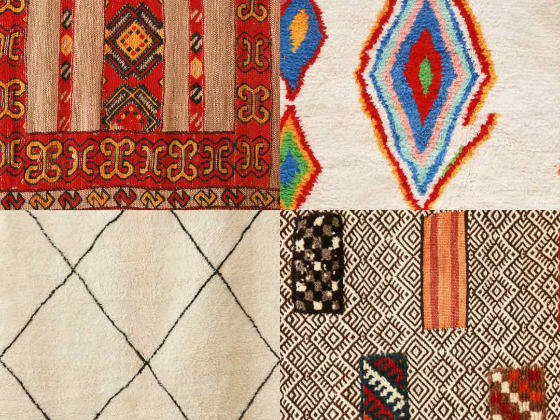
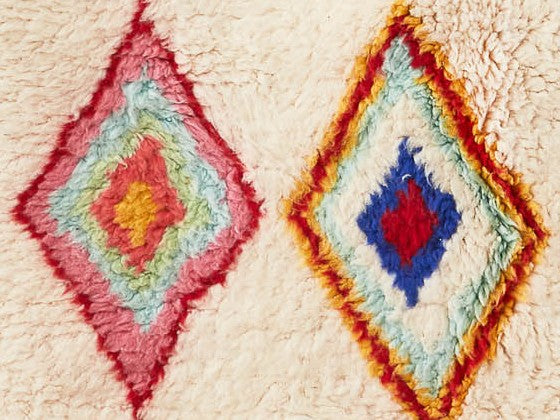
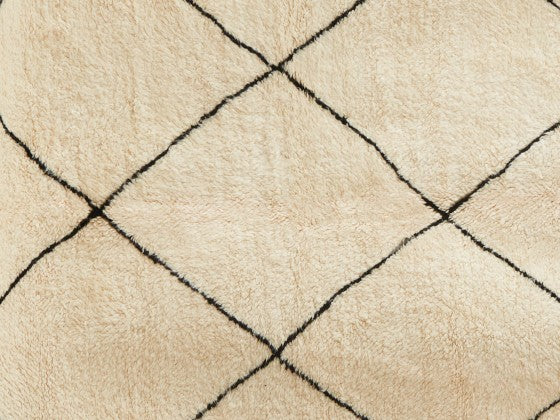
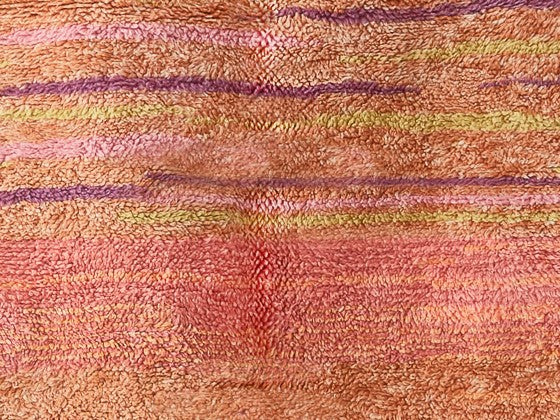
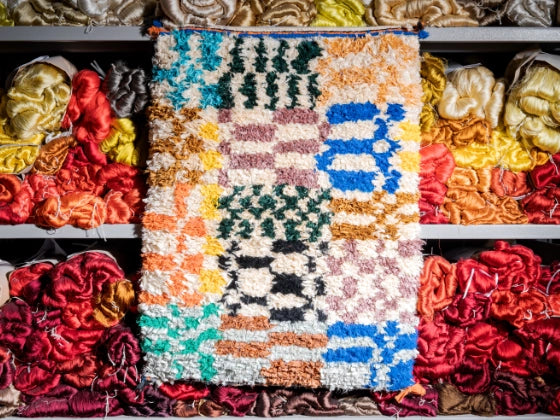
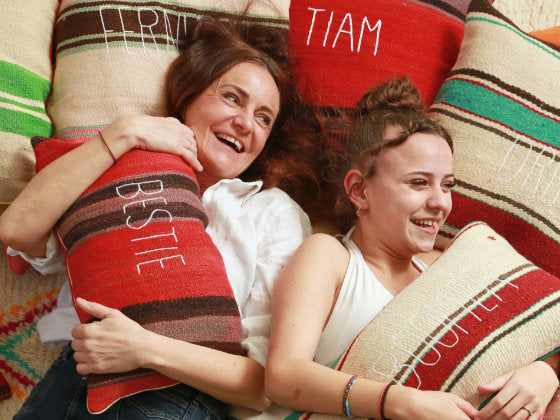
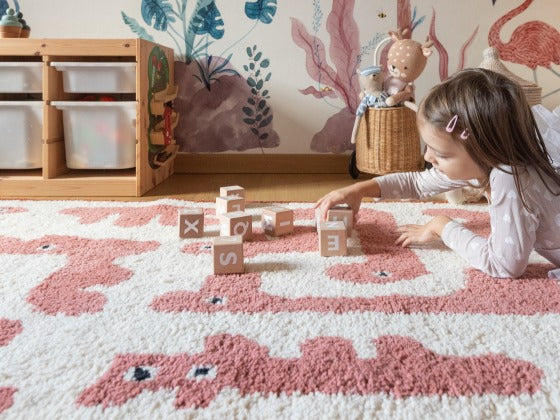

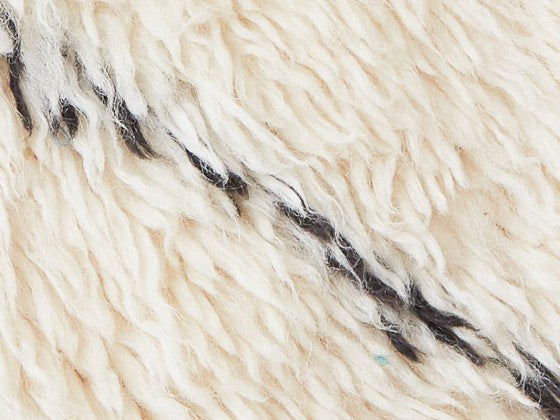
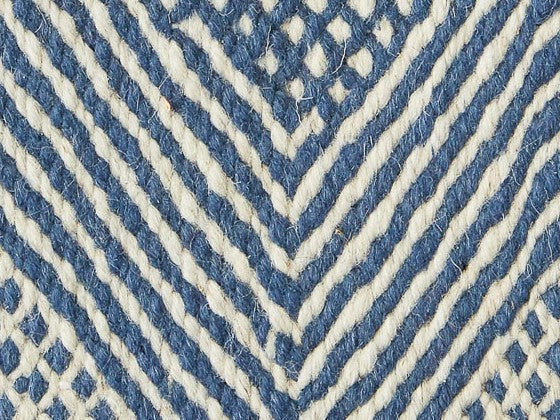
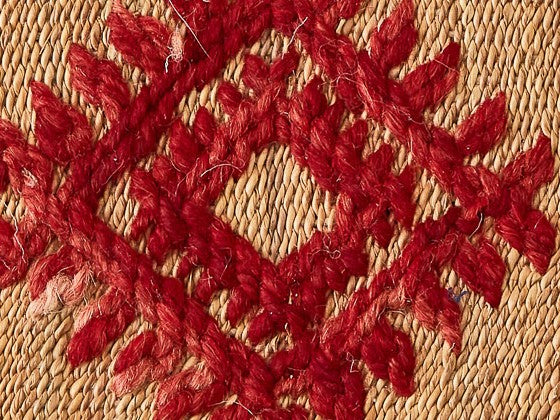

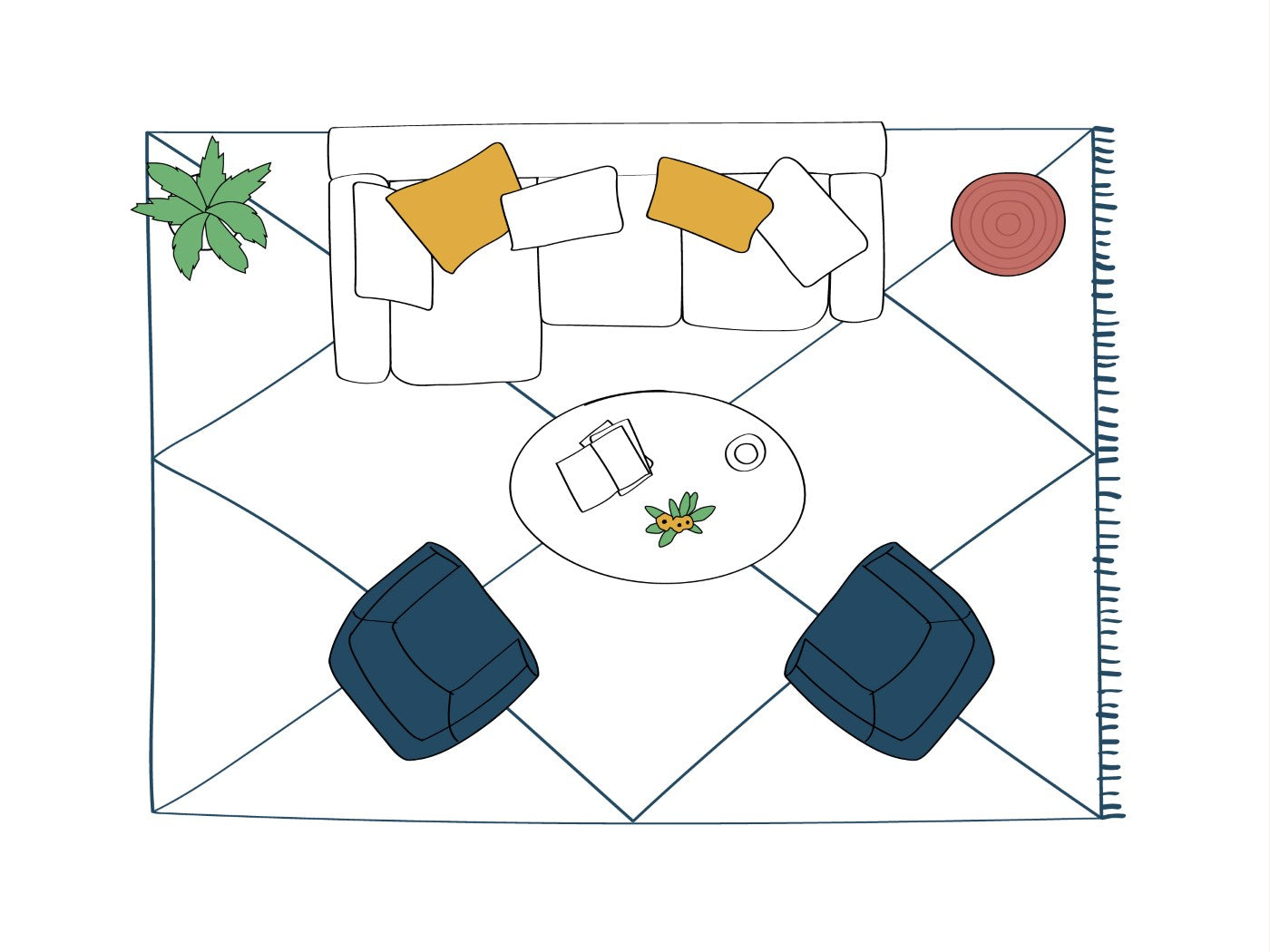

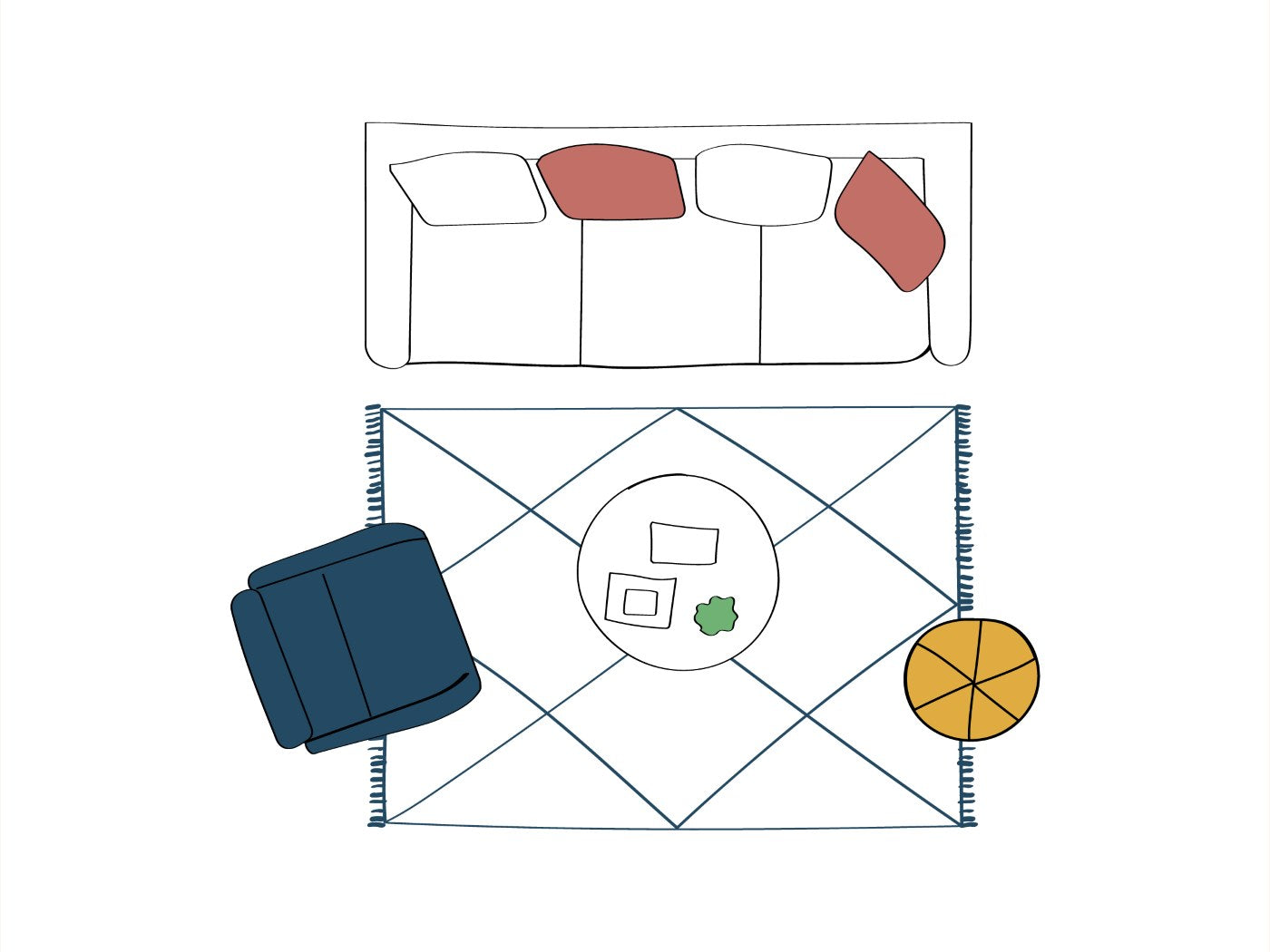
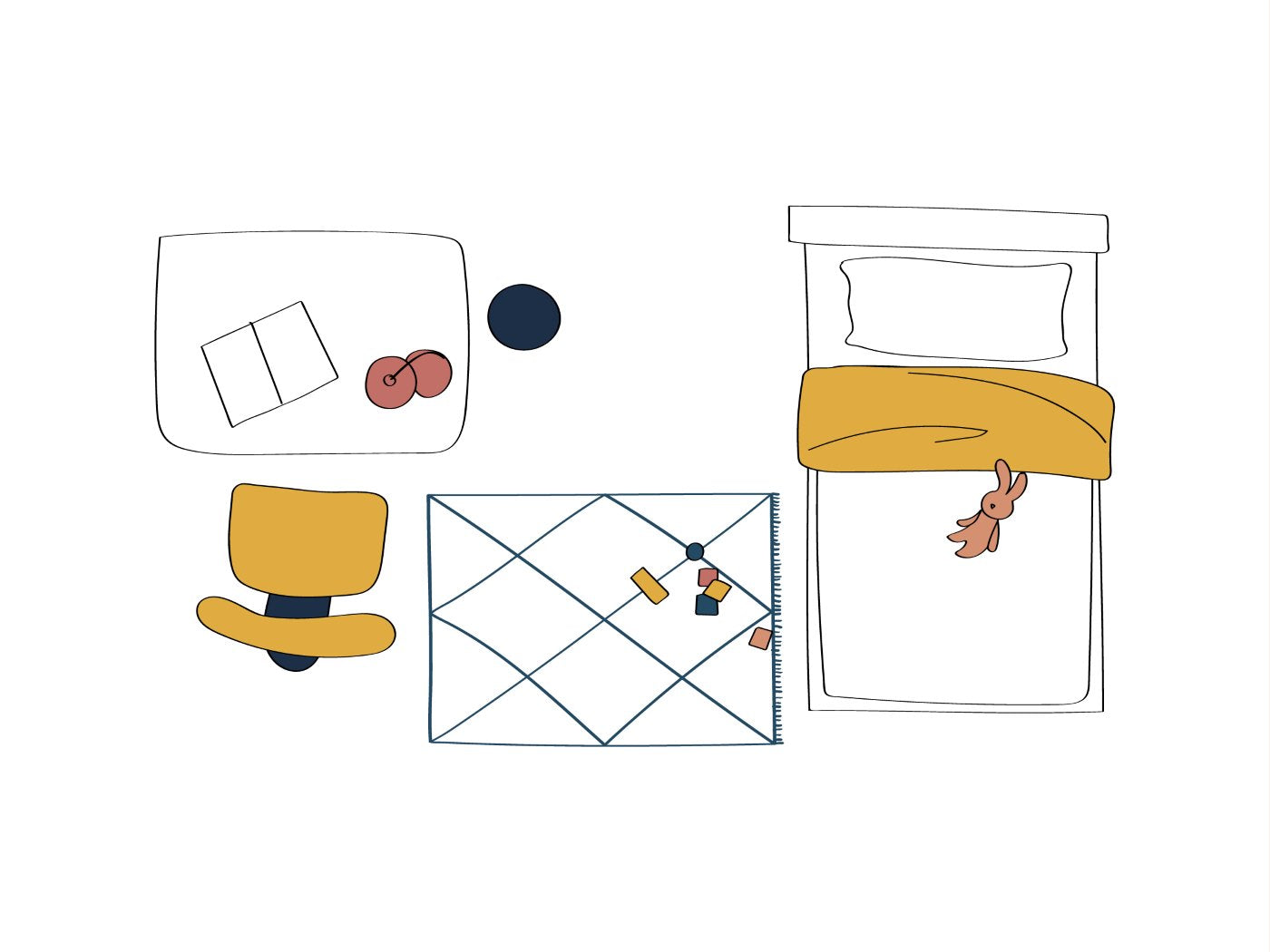
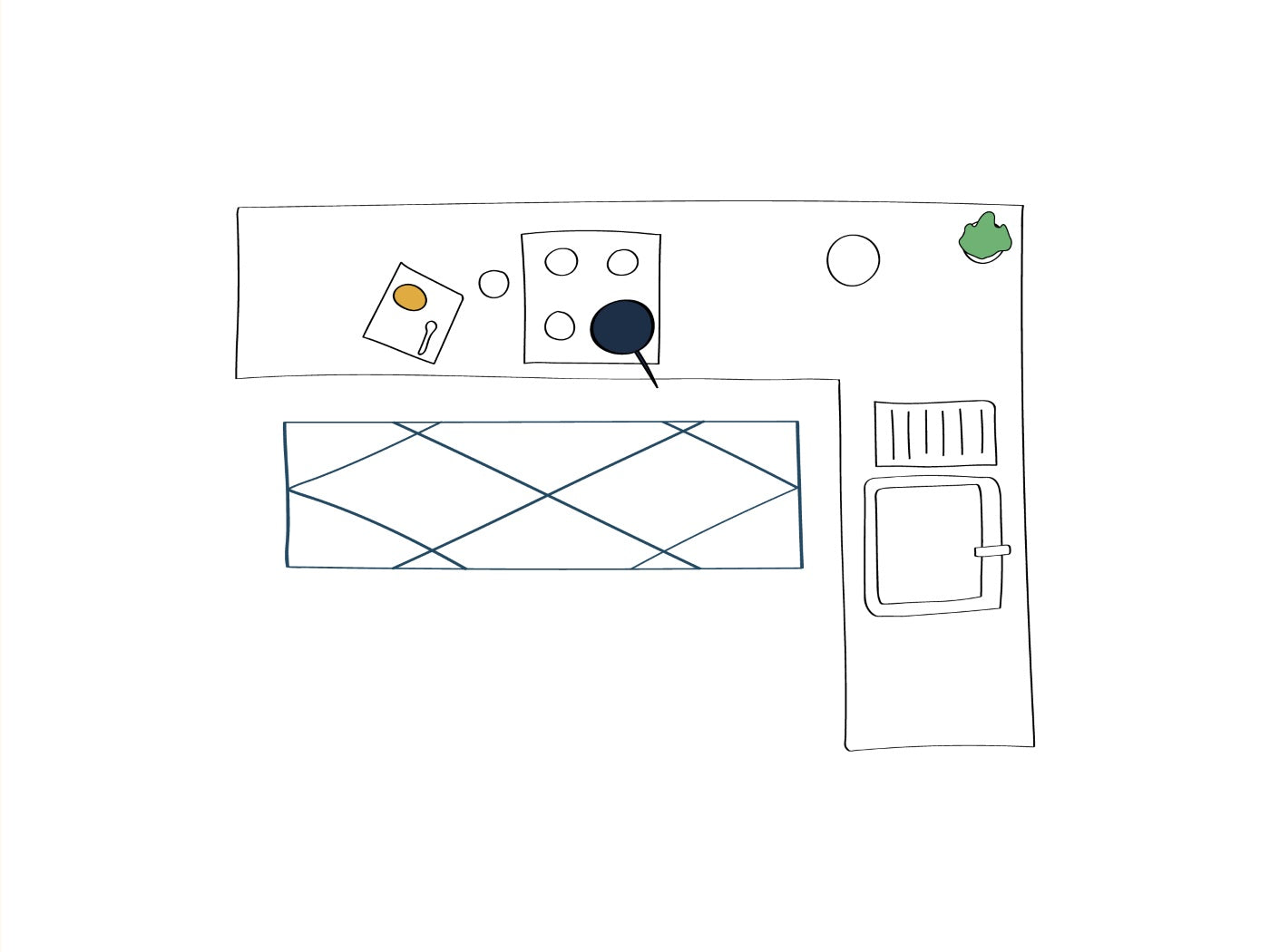
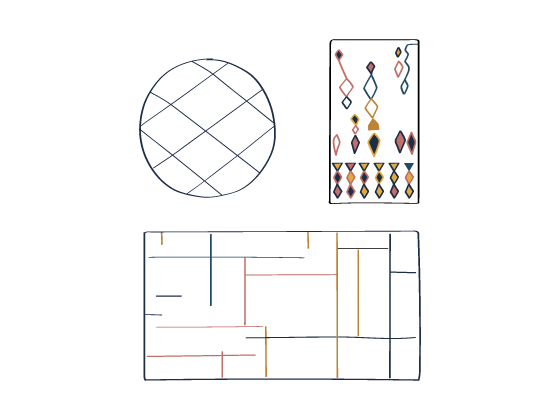
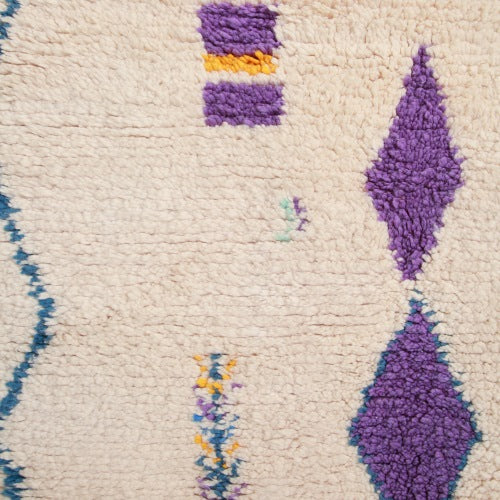
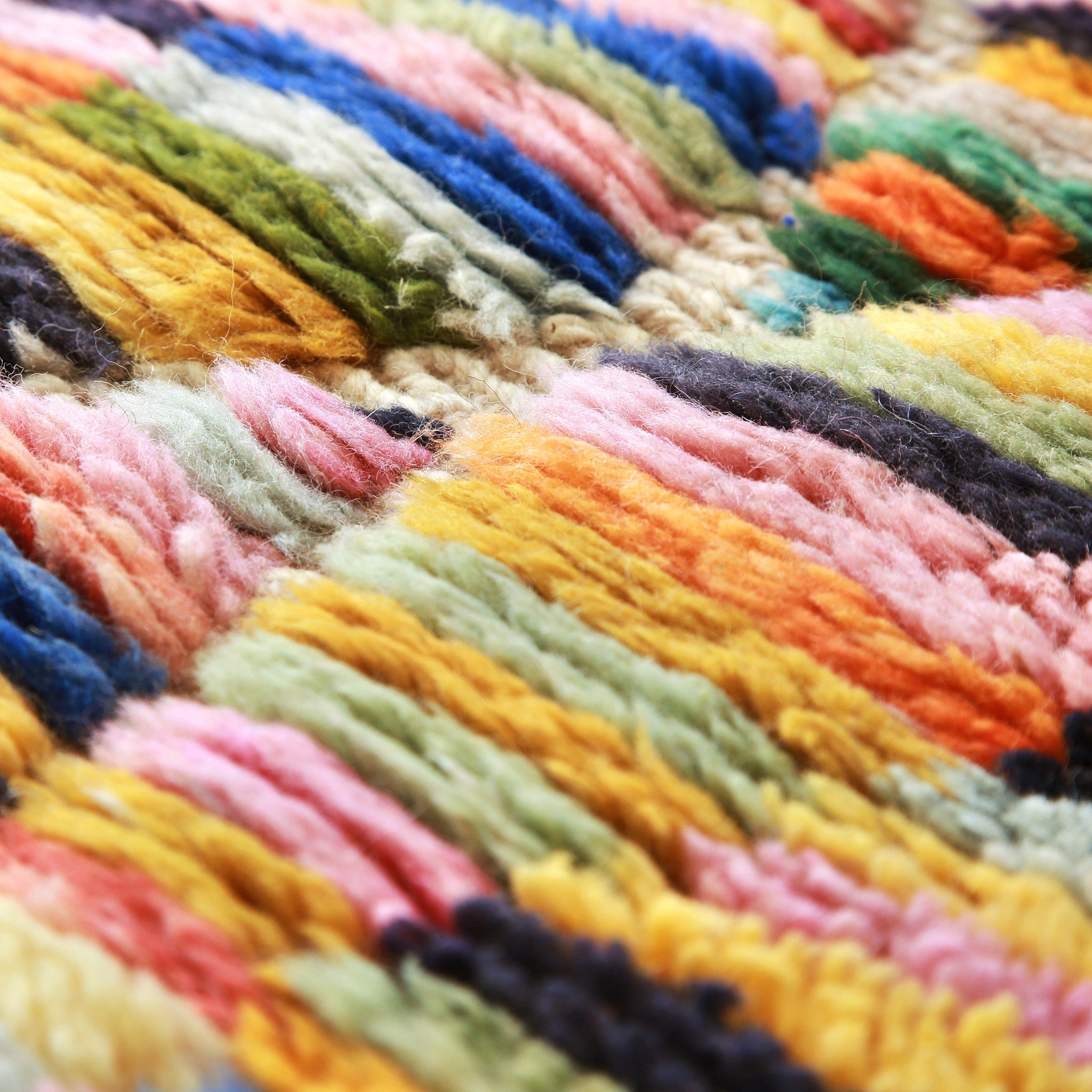

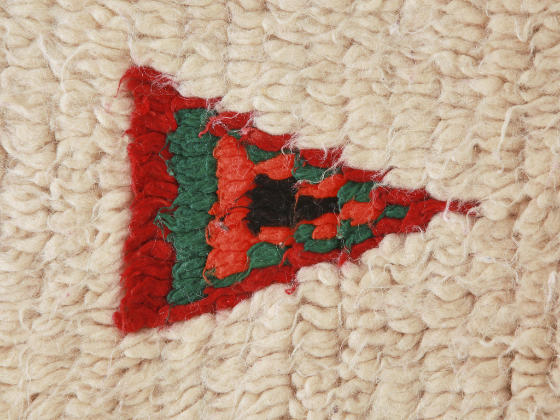
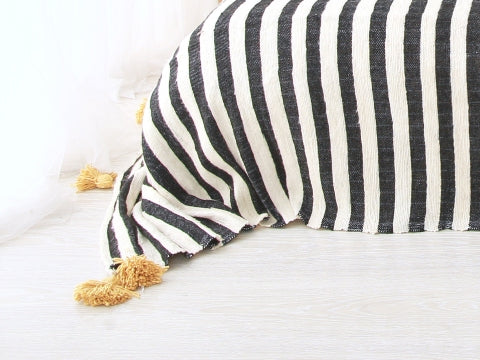
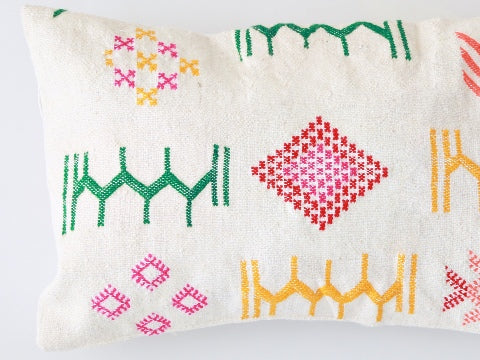
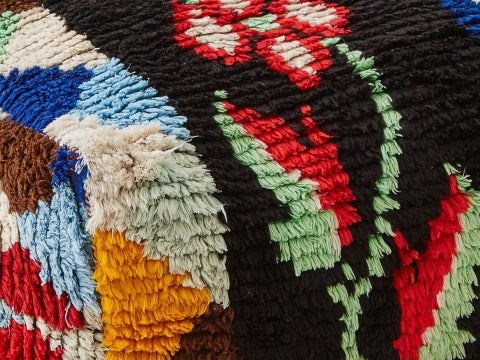

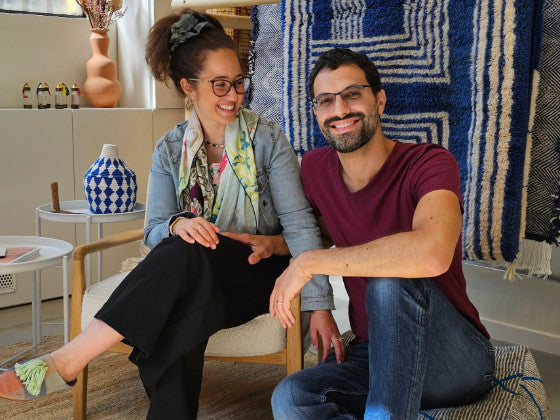
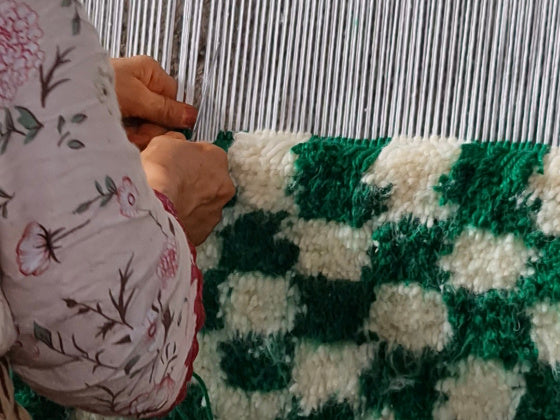
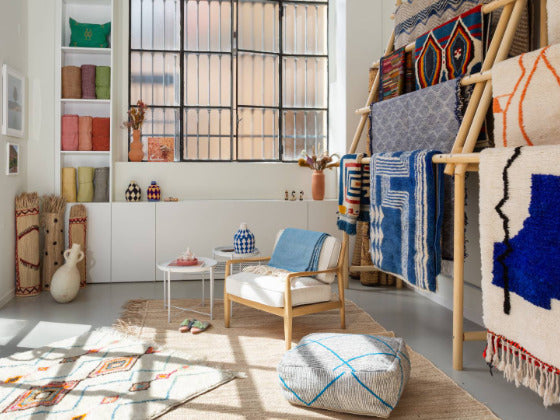
![Come posizionare i tappeti in casa [con esempi pratici stanza per stanza]](http://casaamar.it/cdn/shop/articles/tappeto-salotto-divano-moderno_6edbdebb-c3c3-4843-9831-ca971137a52e.jpg?v=1759833613&width=1500)
